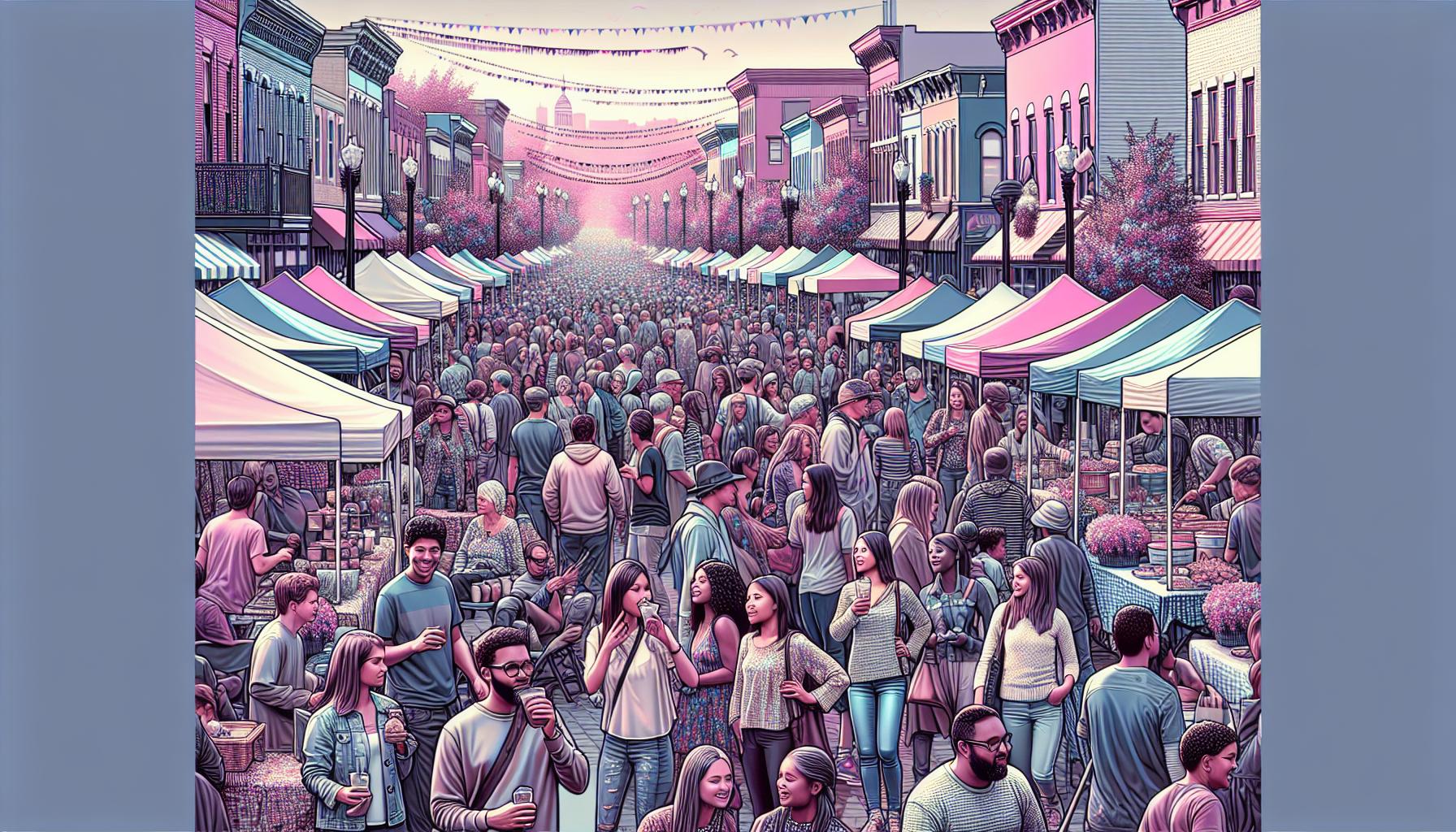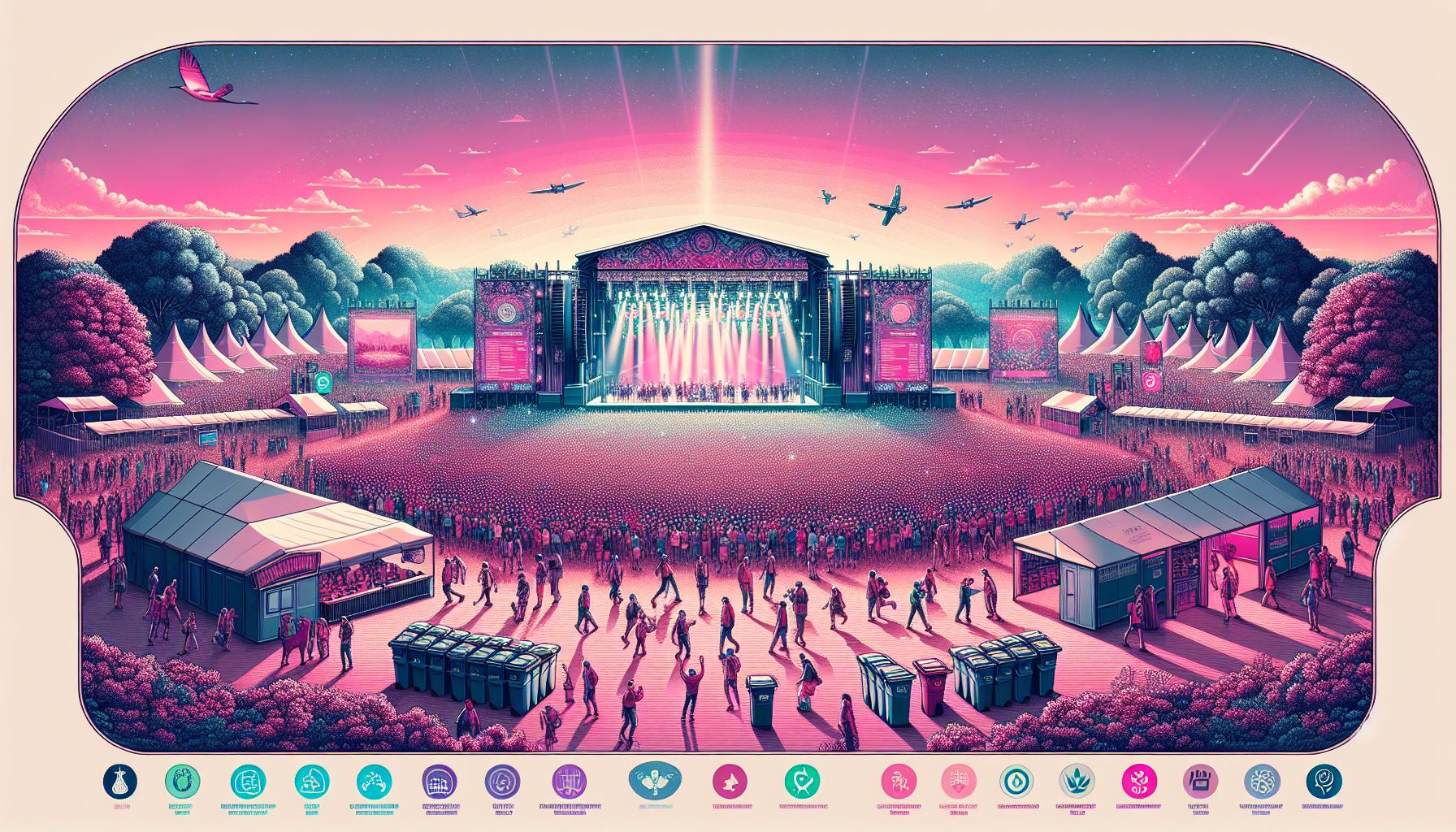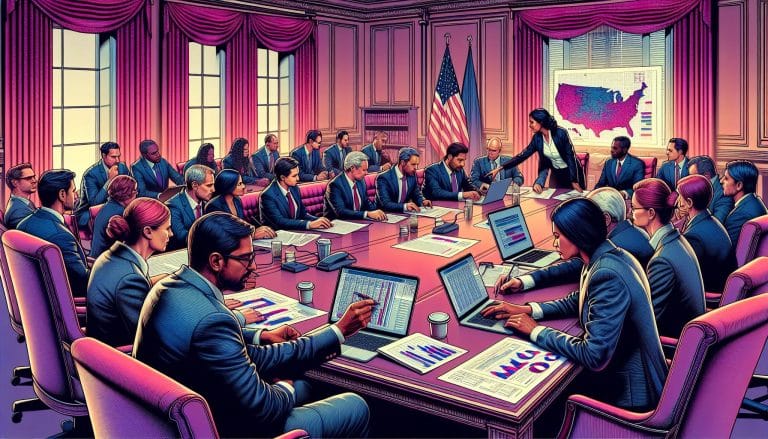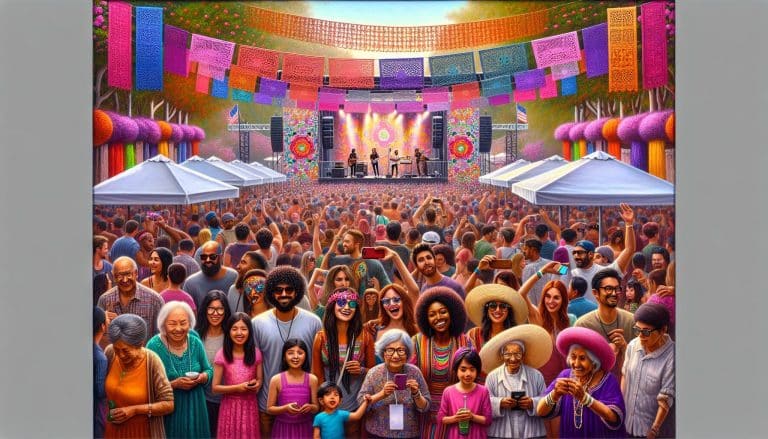Festivals can be a game-changer for your local economy, especially when it comes to tourism. As an event organizer or venue owner, you’re in a unique position to harness the power of these cultural celebrations to boost your community’s economic growth.
The impact of festivals on tourism goes far beyond ticket sales. These events attract visitors from near and far, filling hotels, restaurants, and shops with eager customers. They create jobs, stimulate local businesses, and generate tax revenue for your city or region. But that’s just the tip of the iceberg. Understanding the full economic potential of festivals can help you maximize their benefits and create lasting value for your community.
Key Takeaways
- Festivals generate significant direct economic benefits through visitor spending on accommodation, food, transportation, and retail.
- Indirect economic effects include job creation, infrastructure improvements, and enhanced destination branding.
- Measuring economic impact involves visitor surveys, data collection, and economic impact modeling techniques.
- Factors influencing a festival’s economic impact include size, duration, location, accessibility, and cultural significance.
- Maximizing benefits requires partnerships with local businesses, sustainable practices, and strategies to encourage extended stays and year-round tourism.
Understanding the Economic Impact of Festivals on Tourism
Direct Economic Benefits
Festivals generate immediate economic benefits through visitor spending. Tourists attending festivals spend money on:
- Accommodation (hotels, vacation rentals)
- Food and beverages (restaurants, cafes, food vendors)
- Transportation (taxis, public transit, car rentals)
- Retail purchases (souvenirs, local products)
- Entertainment (additional attractions, activities)
This influx of spending stimulates local businesses and contributes to the overall economy. Track these expenditures using surveys or economic impact assessment tools to quantify the direct economic impact of your festival.
Indirect Economic Effects
Festivals create a ripple effect in the local economy:
- Supply chain boost: Local suppliers benefit from increased demand for goods and services
- Job creation: Temporary and permanent positions in hospitality, event management, and support services
- Infrastructure improvements: Festival-related upgrades to venues and transportation systems
- Marketing value: Increased exposure for the destination, attracting future visitors
Analyze these indirect effects by collaborating with local economic development agencies and using economic multiplier models.
Long-term Economic Impact
Festivals contribute to long-term economic growth:
- Destination branding: Enhances the location’s reputation as a cultural hub
- Return visits: Satisfied attendees are more likely to revisit the destination
- Business attraction: Successful events can attract new businesses to the area
- Community development: Festival revenues can fund local projects and initiatives
Monitor these long-term impacts through longitudinal studies and community surveys. Use The Ticket Fairy’s analytics tools to track repeat attendees and gauge customer satisfaction.
Measuring Economic Impact
Quantify the economic impact of your festival:
- Conduct visitor surveys to gather spending data
- Collect data on hotel occupancy rates and average daily rates
- Analyze tax revenue increases during the festival period
- Use economic impact modeling software
- Collaborate with local universities or economic research firms
Present your findings to stakeholders, sponsors, and local government to demonstrate the festival’s value and secure support for future events.
Maximizing Economic Benefits
Optimize your festival’s economic impact:
- Partner with local businesses to create package deals
- Extend the festival duration to encourage longer stays
- Promote local attractions and activities to increase overall spending
- Implement sustainable practices to reduce environmental costs
- Utilize The Ticket Fairy’s marketing tools to reach a wider audience and boost attendance
By understanding and maximizing the economic impact of your festival, you create a win-win situation for both the event and the local community.
Direct Economic Effects
Festivals generate substantial direct economic impacts on tourism through various channels. These effects are immediately visible and quantifiable, contributing significantly to the local economy.
Visitor Spending Patterns
Festivals drive visitor spending across multiple sectors of the local economy. Attendees spend money on:
- Accommodation: Hotels, vacation rentals, and campsites experience increased bookings during festival periods.
- Food and beverages: Restaurants, cafes, and food vendors see a surge in sales.
- Transportation: Taxis, ride-sharing services, and public transit benefit from increased ridership.
- Retail: Local shops and boutiques often report higher sales volumes.
- Entertainment: Complementary attractions and activities in the area gain more visitors.
To maximize visitor spending, partner with local businesses to offer festival-specific discounts or packages. Utilize The Ticket Fairy’s platform to promote these offers directly to ticket buyers, increasing their awareness of local spending opportunities.
Job Creation and Employment Opportunities
Festivals contribute to job creation and employment in several ways:
- Temporary event staff: Hiring for security, ticketing, setup, and maintenance positions.
- Hospitality sector: Increased demand leads to additional shifts for hotel and restaurant staff.
- Transportation services: More drivers needed for taxis, buses, and ride-sharing services.
- Local artisans and vendors: Opportunities for selling crafts, food, and merchandise at the festival.
- Marketing and promotion: Jobs in advertising, social media management, and public relations.
To enhance job creation, extend festival durations or create off-season events. This approach provides more stable employment opportunities for local residents. Collaborate with local workforce development agencies to recruit and train staff, ensuring a skilled labor pool for future events.
Indirect and Induced Economic Effects

Festivals generate economic impacts beyond direct spending, creating ripple effects throughout the local economy. These indirect and induced effects amplify the overall economic benefits of festivals on tourism.
Local Business Growth
Festivals stimulate local business growth by increasing demand for goods and services. This growth extends beyond businesses directly involved in the festival:
- Supply chain expansion: Local suppliers experience increased orders for materials and services needed for the festival.
- Increased foot traffic: Nearby businesses benefit from higher customer volumes during and after the event.
- Extended stays: Visitors often explore the area beyond the festival, patronizing local attractions and businesses.
- Brand exposure: Local products and services gain visibility through festival sponsorships and vendor opportunities.
To maximize local business growth:
- Partner with local suppliers for festival needs
- Create a festival map highlighting nearby businesses
- Offer joint promotions with local attractions
- Use The Ticket Fairy’s platform to showcase local business sponsors
Tax Revenue Generation
Festivals contribute significantly to local tax revenue, benefiting the entire community:
- Sales tax: Increased visitor spending leads to higher sales tax collection.
- Hotel occupancy tax: Influx of tourists boosts hotel bookings and related taxes.
- Business license fees: Temporary vendors and pop-up businesses generate additional licensing revenue.
- Property tax: Long-term economic growth can increase property values and related tax revenue.
- Track and report economic impact data to local authorities
- Collaborate with local government to allocate festival-generated taxes for community improvements
- Encourage visitors to explore the area and extend their stay
- Use The Ticket Fairy’s analytics to demonstrate the festival’s economic impact to stakeholders
Measuring Economic Impact

Accurately measuring the economic impact of festivals on tourism requires systematic data collection and analysis. Here’s how to approach this task effectively:
Data Collection Methods
Implement multiple data collection methods to capture comprehensive information about festival attendees and their spending patterns:
- Surveys: Distribute surveys to attendees during and after the event to gather demographic information, spending habits, and travel details.
- Point-of-sale data: Collect data from vendors and local businesses to track sales directly attributable to the festival.
- Ticketing information: Analyze ticket sales data to determine attendance numbers and visitor origins.
- Hotel occupancy rates: Gather data from local accommodations to measure the influx of out-of-town visitors.
- Transportation data: Collect information on public transit usage, parking fees, and car rentals to assess transportation-related spending.
- Social media analytics: Monitor social media engagement and check-ins to gauge attendance and visitor sentiment.
Survey Instrument Development
Create effective survey instruments to collect accurate and relevant data:
- Define objectives: Clearly outline the specific economic impact factors you aim to measure.
- Design questions: Craft concise, unambiguous questions that directly address your objectives.
- Include spending categories: Break down spending into specific categories such as lodging, food, transportation, and merchandise.
- Capture demographic information: Collect data on age, income, location, and group size to segment attendees.
- Use appropriate scales: Employ Likert scales or multiple-choice options for ease of analysis.
- Pilot test: Conduct a trial run of your survey to identify and rectify any issues before full implementation.
- Ensure anonymity: Guarantee respondent privacy to encourage honest responses.
Economic Impact Analysis Techniques
Apply robust analytical techniques to process the collected data and derive meaningful insights:
- Input-Output modeling: Use economic multipliers to estimate indirect and induced impacts on the local economy.
- Economic impact software: Utilize specialized software like IMPLAN or REMI to calculate total economic impact.
- Visitor spending analysis: Calculate average per-visitor spending and extrapolate to total attendance figures.
- Employment impact assessment: Estimate the number of jobs created or supported by the festival.
- Tax revenue calculation: Determine the additional tax revenue generated for local and state governments.
- Comparative analysis: Compare economic impact data across different years or similar events to identify trends.
- Sensitivity analysis: Conduct tests to account for potential variations in key variables and ensure robust results.
Implement these methods and techniques to accurately measure and report the economic impact of your festival on tourism. Use platforms like The Ticket Fairy to streamline data collection through integrated ticketing and analytics features, enhancing the accuracy of your economic impact assessment.
Factors Influencing Economic Impact
The economic impact of festivals on tourism varies significantly based on several key factors. Understanding these factors helps event organizers and local authorities maximize the economic benefits of festivals.
Festival Size and Duration
Festival size and duration directly correlate with economic impact. Larger festivals with longer durations typically generate more substantial economic benefits:
- Attendance numbers: Higher attendance leads to increased spending on accommodation, food, and local attractions.
- Multi-day events: Extended festivals encourage longer stays, resulting in higher hotel occupancy rates and increased local spending.
- Scale of operations: Larger festivals often require more extensive infrastructure and staffing, creating additional job opportunities and local business contracts.
- Vendor participation: More vendors mean a wider variety of goods and services, potentially attracting diverse audiences and increasing overall spending.
Use Ticket Fairy’s analytics tools to track attendance patterns and optimize your festival’s duration for maximum economic impact.
Location and Accessibility
The festival’s location and ease of access play crucial roles in its economic impact:
- Urban vs. rural settings: Urban festivals benefit from existing infrastructure but face higher operational costs. Rural festivals may have lower costs but require more investment in temporary infrastructure.
- Transportation links: Easily accessible locations via public transport or major highways attract more visitors, including those from out of town.
- Proximity to attractions: Festivals near other tourist attractions encourage extended stays and increased overall tourism spending.
- Local amenities: The availability of accommodation, restaurants, and shopping options in the vicinity affects visitor spending patterns.
- Parking facilities: Adequate parking encourages more local and regional attendees, potentially increasing day-visitor spending.
Consider partnering with local transportation providers to offer shuttle services, enhancing accessibility and extending the festival’s economic reach.
Cultural Significance and Uniqueness
Festivals with strong cultural ties or unique offerings often have a more significant economic impact:
- Cultural heritage: Events celebrating local traditions attract cultural tourists, who tend to spend more on authentic experiences and souvenirs.
- Niche appeal: Specialized festivals (e.g., film festivals, music genres) draw enthusiasts willing to travel and spend more for their passion.
- Authenticity: Authentic local experiences encourage visitors to engage more deeply with the community, leading to increased spending.
- Novelty factor: Unique or one-of-a-kind festivals generate buzz, attracting media attention and first-time visitors.
- Repeat visitors: Culturally significant annual events often create loyal attendees who return year after year, providing consistent economic benefits.
Leverage Ticket Fairy’s marketing tools to highlight your festival’s unique cultural aspects and attract a dedicated audience, potentially increasing its economic impact.
Benefits Beyond Direct Spending

Festivals generate economic impacts that extend far beyond immediate tourist expenditures. These additional benefits contribute to long-term community growth and cultural enrichment.
Community Engagement and Social Connections
Festivals foster stronger community bonds and social cohesion. Local residents actively participate in festival planning, volunteering, and attendance, creating a sense of shared ownership. This increased engagement leads to:
- Enhanced civic pride: Residents take pride in showcasing their community to visitors
- Improved social capital: Networks and relationships formed during festivals persist long after the event
- Increased volunteerism: Festivals provide opportunities for locals to contribute their time and skills
- Strengthened community identity: Shared experiences during festivals reinforce a collective sense of belonging
To maximize community engagement, use The Ticket Fairy’s volunteer management tools to coordinate local participation efficiently.
Cultural Exchange and Diversity Promotion
Festivals serve as platforms for cultural exchange and diversity promotion, benefiting both local communities and tourists. These events:
- Showcase local traditions: Visitors gain authentic experiences of local customs, arts, and heritage
- Facilitate cross-cultural interactions: Attendees from diverse backgrounds engage in meaningful exchanges
- Preserve cultural heritage: Festivals motivate communities to maintain and celebrate their unique traditions
- Promote cultural understanding: Exposure to different cultures fosters tolerance and appreciation for diversity
Leverage The Ticket Fairy’s audience analytics to identify diverse attendee demographics and tailor programming to promote cultural exchange. Create targeted marketing campaigns to attract a wide range of cultural groups, enhancing the festival’s diversity and appeal.
Challenges and Considerations

While festivals offer significant economic benefits to tourism, they also present several challenges that require careful consideration and management.
Environmental Impact
Festivals can strain local ecosystems and contribute to environmental degradation. Large crowds generate substantial waste, increase carbon emissions from transportation, and may damage natural habitats. Implement eco-friendly practices such as:
- Use biodegradable materials for food containers and utensils
- Set up recycling stations throughout the festival grounds
- Encourage public transportation or carpooling to reduce vehicle emissions
- Partner with local environmental organizations for cleanup efforts
- Utilize The Ticket Fairy’s digital ticketing system to minimize paper waste
Infrastructure Strain
Festivals often test the limits of local infrastructure, potentially causing inconvenience to residents and long-term damage to facilities. Address these concerns by:
- Coordinating with local authorities to manage traffic flow and parking
- Upgrading temporary facilities like portable toilets and waste management systems
- Reinforcing existing infrastructure to handle increased usage
- Implementing crowd control measures to prevent overcrowding
- Using The Ticket Fairy’s audience analytics to predict and manage attendance levels
- Developing off-season attractions or smaller events to maintain tourist interest
- Creating partnerships with local businesses to offer festival-themed products or experiences throughout the year
- Investing in multi-use venues that serve various purposes beyond festival periods
- Implementing dynamic pricing strategies to maximize revenue during peak seasons
- Utilizing The Ticket Fairy’s marketing tools to promote year-round engagement with festival brands
Case Studies: Successful Festival Tourism Models
Coachella Valley Music and Arts Festival
Coachella exemplifies a successful festival tourism model. The event attracts 250,000 attendees annually, generating $704 million in economic impact for the Coachella Valley region. Key factors contributing to its success:
- Extended duration: Two three-day weekends maximize visitor spending
- Diverse lineup: Attracts a wide range of music fans
- Unique desert setting: Creates an iconic festival experience
- Robust partnerships: Collaborations with local businesses boost regional economy
To replicate Coachella’s success, utilize The Ticket Fairy’s analytics tools to optimize your lineup and maximize ticket sales across multiple event days.
Edinburgh Festival Fringe
The Edinburgh Festival Fringe demonstrates the power of cultural festivals in driving tourism. This month-long event generates £200 million annually for the Scottish economy. Notable strategies include:
- Open-access format: Encourages diverse performances and attracts varied audiences
- City-wide integration: Transforms Edinburgh into a cultural hub
- Year-round marketing: Maintains interest and attracts international visitors
- Multi-venue approach: Spreads economic benefits throughout the city
Implement a similar model by using The Ticket Fairy’s multi-event management features to coordinate performances across various venues.
Oktoberfest, Munich
Oktoberfest showcases how traditional festivals can become major tourism drivers. The event attracts 6 million visitors and generates €1.23 billion in economic impact. Success factors include:
- Cultural authenticity: Celebrates Bavarian traditions
- Global branding: Markets the festival as a quintessential German experience
- Extended duration: 16-18 day run maximizes economic benefits
- Comprehensive offerings: Combines food, drink, and entertainment
Enhance your festival’s cultural appeal by using The Ticket Fairy’s targeted marketing tools to reach international audiences interested in authentic experiences.
South by Southwest (SXSW), Austin
SXSW illustrates the potential of multi-industry festivals. The event contributes $355.9 million to Austin’s economy annually. Key strategies:
- Diverse programming: Combines music, film, and technology conferences
- Industry networking: Attracts professionals and creates business opportunities
- City-wide participation: Engages local venues and businesses
- Innovation focus: Positions Austin as a tech and creative hub
Implement a multi-faceted approach by using The Ticket Fairy’s customizable ticketing options to create diverse ticket types for different event components.
Tomorrowland, Belgium
Tomorrowland demonstrates the power of immersive experiences in festival tourism. The event generates €100 million in economic impact for the Boom region. Success elements include:
- Themed environments: Creates a fantasy world for attendees
- International appeal: Attracts visitors from over 200 countries
- Extended stay options: Offers on-site camping and nearby accommodations
- Digital engagement: Leverages live streaming to expand global reach
Enhance your festival’s immersive elements by using The Ticket Fairy’s RFID wristband technology for seamless on-site experiences and data collection.
Maximizing Economic Benefits for Host Communities
Develop Strong Partnerships with Local Businesses
Forge strategic alliances with local businesses to create a mutually beneficial ecosystem. Collaborate with hotels, restaurants, and transportation services to offer festival packages. Implement a local vendor program, giving preference to community-based businesses for festival supplies and services. Use The Ticket Fairy’s partner management tools to streamline communication and track economic impact across various sectors.
Implement Sustainable Tourism Practices
Adopt eco-friendly measures to reduce the festival’s environmental footprint. Introduce waste reduction initiatives, renewable energy sources, and sustainable transportation options. Promote these efforts to attract environmentally conscious tourists and enhance the festival’s reputation. Utilize The Ticket Fairy’s customizable ticketing options to offer incentives for attendees who choose sustainable travel methods.
Create Year-Round Tourism Opportunities
Extend the economic impact beyond the festival dates by developing year-round attractions. Establish a festival museum or cultural center showcasing the event’s history and local heritage. Organize off-season events or workshops related to the festival’s theme. Use The Ticket Fairy’s audience insights to identify potential interest in these supplementary activities and tailor marketing efforts accordingly.
Invest in Local Infrastructure and Skills Development
Allocate a portion of festival revenues for community infrastructure improvements. Upgrade public spaces, enhance transportation networks, and invest in cultural facilities. Implement training programs for local residents in event management, hospitality, and technical skills. This investment creates a skilled workforce for future events and improves the overall tourism infrastructure.
Encourage Extended Stays and Exploration
Design pre and post-festival experiences to entice visitors to extend their stay. Curate guided tours of local attractions, organize cultural workshops, or offer exclusive performances. Partner with regional tourism boards to promote nearby destinations. Leverage The Ticket Fairy’s email marketing features to communicate these extended stay options to ticket buyers.
Implement Dynamic Pricing Strategies
Use data-driven pricing models to maximize revenue while ensuring accessibility for different market segments. Analyze historical data and real-time demand to adjust ticket prices. Offer tiered pricing options, including VIP packages and early bird discounts. The Ticket Fairy’s advanced pricing tools enable you to implement these strategies effectively, balancing profit maximization with community inclusivity.
Foster Cultural Exchange and Authenticity
Showcase local traditions, arts, and cuisine alongside international attractions. Create spaces for cultural dialogue and exchange between visitors and residents. This approach enhances the visitor experience and strengthens community pride. Use The Ticket Fairy’s event customization features to highlight these authentic local experiences in your festival promotion.
Establish a Community Reinvestment Program
Allocate a percentage of festival profits for community development projects. Create a transparent process for selecting initiatives that align with local needs and festival values. This reinvestment strengthens community support and creates a positive cycle of economic growth. Communicate these efforts through The Ticket Fairy’s marketing channels to build goodwill among attendees and stakeholders.
Conclusion: The Future of Festival Tourism
Festivals hold immense potential to boost local economies through tourism. By implementing strategic approaches and leveraging advanced tools you can maximize the economic benefits for host communities. The future of festival tourism lies in sustainable practices collaborative partnerships and innovative technologies. As you embrace these strategies you’ll not only enhance the immediate economic impact but also foster long-term growth and cultural enrichment. Remember the key is to create a positive ripple effect that extends far beyond the festival dates benefiting both visitors and locals alike.
Frequently Asked Questions
How do festivals impact local economies?
Festivals significantly boost local economies by attracting tourists, increasing spending in hospitality sectors, and creating temporary jobs. They stimulate revenue for local businesses, hotels, and restaurants. The economic impact varies based on festival size, duration, and cultural uniqueness. Accurate measurement through data analysis is crucial to understand the full economic benefits.
What strategies can maximize economic benefits for host communities?
Host communities can maximize economic benefits by partnering with local businesses, implementing sustainable tourism practices, and creating year-round tourism opportunities. Investing in local infrastructure, encouraging extended stays, and implementing dynamic pricing strategies are also effective. Additionally, fostering cultural exchange and establishing community reinvestment programs can ensure long-term economic growth.
How can festivals extend their economic impact beyond event dates?
Festivals can extend their economic impact by developing year-round tourism attractions, offering off-season events or workshops, and creating packages that encourage longer stays. Collaborating with local businesses to offer exclusive experiences or discounts throughout the year can also help maintain tourist interest. Leveraging digital platforms to keep audiences engaged between events is another effective strategy.
What role does data analysis play in optimizing festival economics?
Data analysis is crucial for optimizing festival economics. It helps organizers understand attendee behavior, preferences, and spending patterns. This information can be used to tailor marketing strategies, improve ticket pricing, and enhance overall event planning. Tools like The Ticket Fairy’s analytics provide valuable insights for making data-driven decisions to maximize economic benefits.
How can festivals promote sustainable tourism practices?
Festivals can promote sustainable tourism by implementing eco-friendly practices, such as waste reduction and recycling programs. Encouraging the use of public transportation or offering shuttle services can reduce environmental impact. Collaborating with local suppliers and artisans supports the local economy sustainably. Educating attendees about local culture and environmental conservation also contributes to sustainable tourism practices.
What are the benefits of cultural exchange in festival tourism?
Cultural exchange in festival tourism enhances the visitor experience, promotes understanding between diverse groups, and preserves local traditions. It can lead to increased tourism appeal, attracting a wider audience and potentially extending visitor stays. Cultural exchange also contributes to the authenticity of the festival experience, which can result in higher visitor satisfaction and repeat attendance.
You May Also Like:
Top Tips for Producing Pop Culture Conventions That People Will Love
10 Innovative Ways to Boost Your Festival’s Ancillary Revenue: A Complete Guide
How to Create and Promote a Destination Festival: A Step-by-Step Guide



